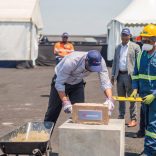Mozambique: Missaua water poisoned with Deltamethrin
Life in Machanga returning to normal – AIM report

Fatima Missionaria
Life in the town of Machanga, in the central Mozambican province of Sofala, is returning to normal as the Save river recedes, and the rain falling in the region slackens, reports Thursday’s issue of the Maputo daily “Noticias”.
The Save flooded the town over last weekend, putting hundreds of houses and most public institutions under water.
Most of the institutions temporarily closed reopened on Wednesday, but the Machanga district administrator, Tome Jose, told “Noticias”, that the local hospital is still functioning in provisional installations.
About 2,000 pupils, taught by 56 teachers, were able to start classes in seven Machanga schools on Wednesday. The school year should have begun on Monday, so these flooded schools were two days late.
But a further 14 schools, attended by 5,000 pupils and 74 teachers, are still inundated, and it has been impossible to begin classes in them.
A survey of agriculture in the district undertaken on Wednesday afternoon shows that the Save floods caused the loss of 3,344 hectares of crops, affecting 4,069 peasant families.
Of the 402 families who took refuge from the floods in four temporary shelters, 162 have now returned to their homes, and more are expected to follow them in the coming days. Tome Jose said that aid is still being airlifted to about 18,000 people in more remote parts of the district, which were isolated by the flood waters. This operation involves three helicopters of the Mozambican Air Force.
In the western province of Tete, where there are fears of possible flooding in the Zambezi valley, the local branch of the Mozambican relief agency, the National Disaster Management Institute (INGC), says it is prepared to make emergency interventions to save lives, should this prove necessary.
The INGC Tete delegate, Joaquim Curipa, told reporters “We are on maximum alert, and we are monitoring the situation on the ground so that we can intervene at any moment”.
The INGC has stationed three boats in Doa and Mutarara districts on the lower Zambezi, and has set up teams, in coordination with the district authorities, which are working to persuade people to abandon flood prone areas and move to higher ground.
Food aid is available for any victims of floods. Curipa said the INGC has stored in its Tete warehouses 920 tonnes of rice, 183 tonnes of maize flour, 90 tonnes of unmilled maize and 30 tonnes of beans.
Rain has been falling everywhere in Mozambique – except the area which most needs it, the Umbeluzi basin in Maputo province, which provides the drinking water for the Greater Maputo Metropolitan Area.
The reservoir at the Pequenos Libombos dam on the Umbeluzi remains less than 14 per cent full. The discharges from the dam dropped from three cubic metres a second to about 2.3 cubic metres a second as from 5 January. According to Wednesday’s issue of the National Hydrological Bulletin, issued by the National Directorate of Water Resources, the discharge is now down to 1.5 cubic metres a second.
Since 10 January water has been rationed in Maputo and Matola cities and Boane district. Water is pumped to each neighbourhood on alternate days. But unless the situation improves soon, the Maputo Regional Water Company (AdeM), may be forced to impose tighter restrictions – such as one day with water, followed by two days without for each part of the affected area.












Leave a Reply
Be the First to Comment!
You must be logged in to post a comment.
You must be logged in to post a comment.